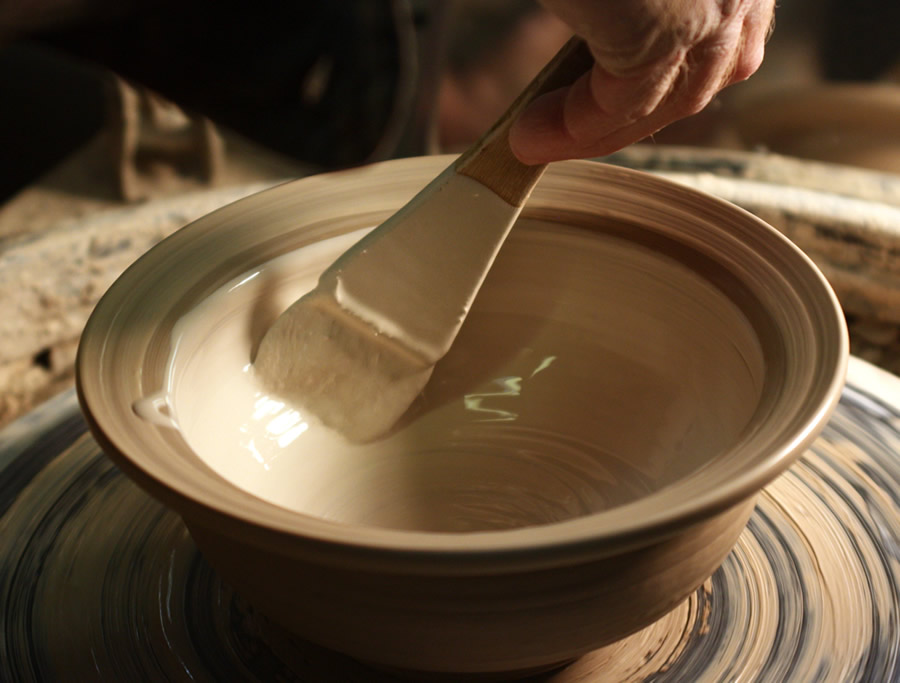 Barry Lockman, Potter
Barry Lockman, Potter
Contact Info: 704-840-4143 • lockmanpottery.com
GA: How did you get started in pottery?
Barry: In 1970, I began carving wood gotten from my cousins sawmill. From walnut and oak butt pieces I carved bowls using chisels. After awhile, I decided learning to draw could help me better design bowls, so I took art classes at Gaston College. One day I walked thru the clay shop. Clay spinning on the wheel mesmerized me. Thereafter, Frank Creech and Dexter Benedict taught me in art, sculpture and pottery classes.
GA: Your pieces are handmade from start to finish- is it true that you dig and prepare your own clay?
Barry: My clay heroes were Michael Cardew, Bernard Leach (both English potters) and Shoji Hamada a Japanese potter. In his book, “Pioneer Pottery”, Cardew based in part on his years spent teaching pottery in remote areas of the Gold Coast and Nigeria in Africa, describes a basic approach to pot making. Involved was the process of digging, processing local clay and other materials for making and glazing pottery. Enamored by his “pioneer“ spirit I committed to using local materials as much as possible. I dig my clay on a hillside in east Lincoln county where I played with my 5 brothers as a child. Red clay and granite from my well provide ingredients for slips and glazes. I also use kaolin, silica and feldspar from a Kings Mountain mine.
GA: So you have several years worth of clay bricks waiting in storage?
Barry: Clay mixing occurs once a year. I run the dried clay thru a hammermill which beats the clods to a powder-like consistency.
The clay along with a small amount of kaolin and feldspar are put into a modified cement mixer with water. The resulting slurry is then poured thru a 30 mesh screen onto the dewatering trays. After drying naturally for 4 to 6 weeks the clay is pugged, then stored in airtight refrigerator carcasses. I am currently making pots with clay processed in 2012. The more clay ages the better. (According to some potters, organic matter seems to enhance the plasticity). Clay is a precious gift having taken millions of years to be transformed from rock to fine clay.
GA: Tell us about the process of creating a piece?
Barry: Pot making is an exciting process which also is physically demanding. What exactly motivates me? Don’t really know. The clay itself entices me. The most exciting time occurs when the clay is still glistening with moisture just after throwing. Some of the greatest pots were made thousands of years past. My best pots will be made later today, tomorrow or next year.
GA: Tell us about your kiln…
Barry: My 74 cubic foot sprung arch salt fired kiln was built in 2006.
Ben Davison designed and helped build it. #2 diesel oil gets kiln to cone 5 when wood and salt are added. Common table salt reacts with the silica in the clay and slips to produce a glaze. All surfaces touched by the salt vapors are glazed. Salt firing dates back to the 1200’s in Germany. A potter may have used salt saturated barrel staves or salt impregnated drift wood. The beauty of salt for me the entire pot outside will be affected by the salt vapors. Colors, mostly earth tones, come from oxides and naturally occurring elements in the clay or slips.
GA: How has your work evolved over time?
Barry: My pots in the beginning were almost always functional – that is for daily use in the kitchen. Gradually I began carving clay. Today I can appreciate a coffee mug or a sculpture. Potters world wide offer a kaleidoscope of exciting forms and colors. I am always amazed at the incredible variety of approaches to clay.
GA: Do you do custom pieces?
Barry: Occasionally, I do commissions within my ability to complete.
GA: Where can folks see your work?
Barry: Catawba River Artisans is having a show June 18th at the office of Dr. David Demperio, Belmont Chiropractic Center at 5803 Wilkinson Blvd. in Belmont.
My pottery can also be purchased at the following galleries, museums and shops:
- Arts on Main, Gastonia, NC
- Catawba River Artisans, Belmont, NC
- Gaston County Museum of Art and History, Dallas, NC.
- Hickory Museum of Art, Hickory, NC
- Kings Mountain Art Center (Southern Arts Society), Kings Mountain, NC Kings Mountain
- Historical Museum, Kings Mountain, NC
- Mug Heaven (Online)
- Southern Charm Winery,Inc. Lincolnton, NC
– Article By David Hamrick

